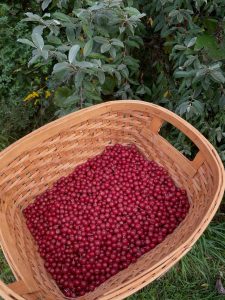Excerpted from Mushroom Wanderland: A Forager’s Guide to Finding, Identifying, and Using More Than 25 Wild Fungi. Copyright (c) 2021 by Jess Starwood. Used with permission of the publisher, The Countryman Press, a division of W. W. Norton & Company, Inc. All rights reserved.
Lactarius rubidus, L. fragilis, L. deliciosus, L. indigo, etc.
When people think of dessert, “mushroom flavor” isn’t usually the first thing that comes to their mind. However, one unusual group of milk cap mushrooms has the overwhelming aroma of maple syrup—a single dehydrated candy cap mushroom (Lactarius rubidus, L. fragilis and L. camphoratus) can scent an entire room. A little definitely goes a long way. They are used for flavoring many culinary treats such as ice cream, cookies, cheesecake, and sauces. Candy caps are also used to flavor alcohol, such as vodka, by infusing dried specimens for a length of time. They can be foraged on both the West and East Coasts or at specialty markets online.

Another species of Lactarius worthy of note is Lactarius deliciosus, the saffron milk cap. While the name may imply that this would be a highly sought-after specimen, it is of mediocre taste and texture compared to other more desirable mushrooms. However, its contrasting colors of orange and green make it an interesting find for the forager’s basket. There are also the remarkable and otherworldly Indigo Milk Caps (Lactarius indigo), which have unusual indigo blue-colored flesh and ooze a bright blue latex when cut, as the name implies.
Some milk caps are edible and delicious, some are poisonous, and others are downright distasteful. It is important to research and learn the subtle differences between the species.
IDENTIFYING FEATURES: The Lactarius genera of mushrooms exhibit a common feature: When cut, they generally ooze a milky substance from their gills, hence their name “milk caps.” This can also be an identifying feature between species. For example, the highly sought after L. rubidus exudes a thin latex reminiscent of skim milk as compared to the toxic L. rufus or “red-hot milk cap,” which has a thicker and pure white latex. Cap and stipe colors can vary widely depending on the species, from reds, oranges, yellow, tan, even blue. Aroma is also an important aspect when identifying many mushrooms, and in this case, the candy cap species will exhibit an unmistakable, powerful, and lingering scent, especially when dried.
Many of our readers find that subscribing to Eat The Planet is the best way to make sure they don't miss any of our valuable information about wild edibles.
See our privacy policy for more information about ads on this site






